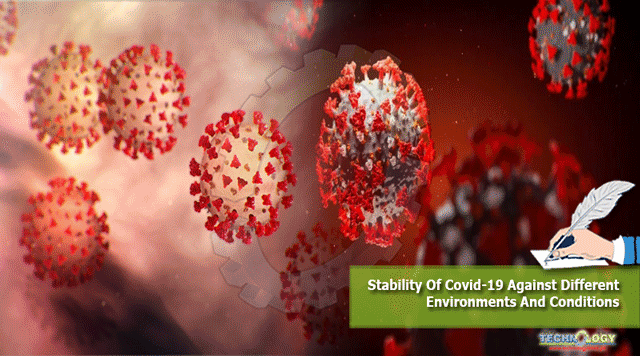The overall study summarize that, the stability of COVID-19 in Air is upto 3 hours,on copper is upto 4 hours,on cardboard is upto 24 hours,on plastic is upto 2-3 days.

In December 2019, a arrangement of human pneumonia cases of unknown cause risen in Wuhan, Hubei, China. Sequencing investigation from lower respiratory tract tests shown a novel corona virus, which changed into name 2019 novel corona virus (SARS-Cov-2) that brought on clusters of lethal pneumonia with clinical introduction significantly taking after SARS CoV. On 30 January WHO has announced it a worldwide health emergency. The simple spread of this infection made individuals wear a veil as preparatory course, utilize gloves, and hand sanitizer on a every day premise that come about within the era of a gigantic amount of therapeutic squanders within the environment. Millions of individuals have been put on lockdown in arrange to diminish the transmission of the infection.
Although air compartment’s particularly meteorological components such as weather conditions, temperature, humidity and air contamination PM10, Black carbon and NOx,plays a key role in COVID-19 transmissions. But the stability and advancement of COVID-19 an infection in other natural compartments such as water, soils, wastewater, and sewage slime need consideration as well.
Right now, the incubation period of novel corona virus is by and large between two and fourteen days , with an normal of five days assessed the length of the incubation period of COVID-19 for 181 affirmed cases exterior Hubei territory, China. According to World Health Organization (WHO) the incubation time from contamination to the introduction of side effects is 5.2 days, with a, extend of 1–14 days. Besides, the meantime from the introduction of indications to looking for restorative exhortation is 5.8 days, and to clinic, affirmation is 12.5 days.Variable perseverance of virus was identified, depending on the sort of virus.
The virus is highly steady at 4°C, but delicate to heat. At 4°C, there was as it were around a 0·7 log-unit lessening of irresistible titer on day 14. With the incubation the temperature expanded to 70°C, the time for infection inactivation was decreased to 5 minutes.Within the show ponder, it illustrated that SARS CoV can survive at slightest two weeks after drying at temperature and stickiness conditions found in an air-conditioned environment. The infection is steady for 3 weeks at room temperature in a fluid environment but it is effortlessly murdered by heat at 56◦C for 15 minutes.
Right now, there are examinations performed to assess the practicality and survival time of SARS-CoV-2. In common, corona viruses are exceptionally steady in a solidified state concurring to considers of other corona viruses, which have appeared survival for up to two a long time at -20°C.For case, at refrigeration temperature (4°C), MERS-CoV can stay practical for up to 72 hours. Current prove on other corona virus strains appears that whereas corona viruses show up to be steady at low and solidifying temperatures for a certain period, food cleanliness and great food security hones can avoid their transmission through nourishment.
A few pointers such as Stickiness and Sun oriented radiation have a converse relationship with contamination rate, in any case, the relationships are not critical concurring to Pearson’s strategy low percent of relative stickiness underpins the survival of virus on the sullied region.Wind speed contains a critical and reverse relationship with the rate of COVID-19 disease rate. Hence, within the lower speed of the wind, the contamination rate is higher.
One study conducted in Iran showed that the average wind speed within the ponder period is 12.727, so based on areas with a high contamination rate, Mazandaran, Golestan, Tehran have lower normal wind speed as 8.3, 9.2 and 9.7 km/h.One the ponder found that other human corona viruses survived as it were two days in dechlorinated tap water and in the healing center wastewater at 20°C.
Noteworthy (99.9% evacuation) of corona viruses was observed in two days in essential sewage emanating at 23°C, two weeks in pasteurized settled sewage at 25 °C and four weeks in reagent review water at 25°C.Higher temperature, high or low pH and daylight all encourage infection reduction.
